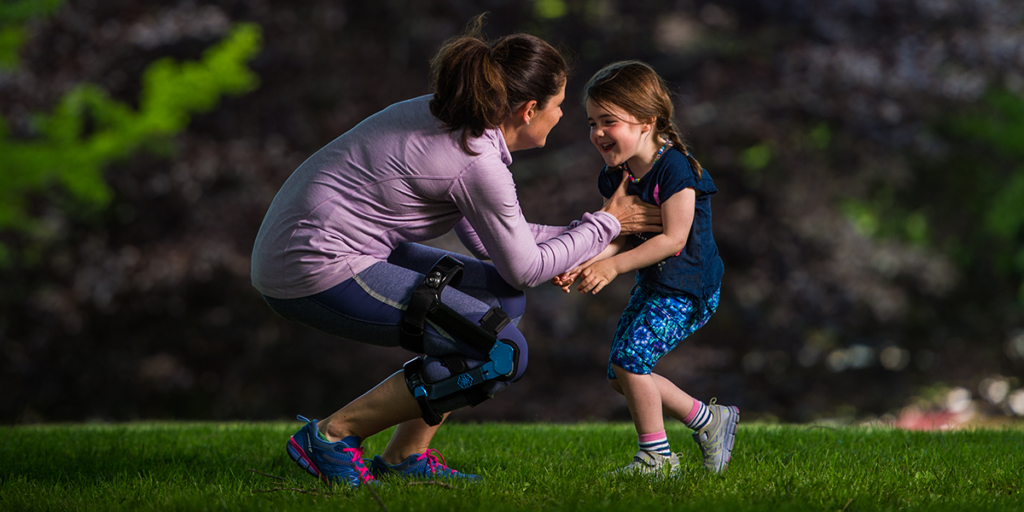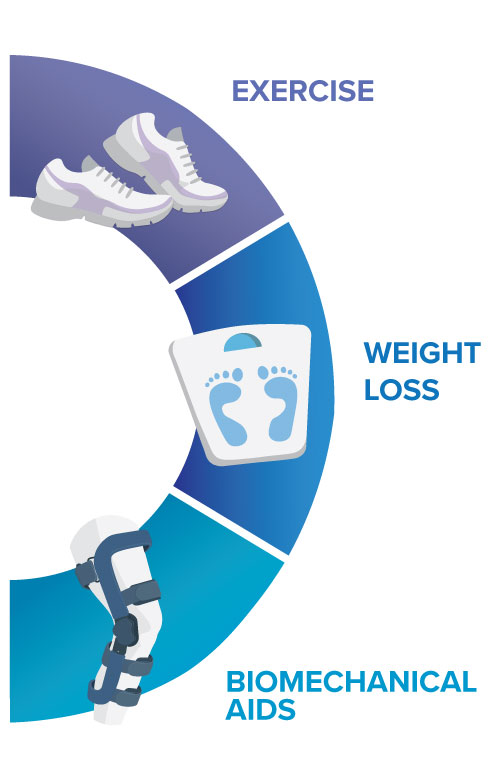Knee Osteoarthritis Patient Resource

Written by Orthopaedic Researcher Matthew Kivell, the following resource is intended to be used as a resource for patients experiencing knee osteoarthritis. Download a copy of this free patient resource.
Knee Osteoarthritis – What is it?
Osteoarthritis (also known as OA) is a top cause of disability in older people. Osteoarthritis is most commonly observed after
the age of 45 or in previously injured joints. However, OA can occur as early as age 20¹.
The goal of osteoarthritis treatment is to reduce pain and improve function².
Osteoarthritis does not always get worse with increasing age, and symptoms can improve. There are a number of possible treatment options that a member of your healthcare team should discuss with you³.
Osteoarthritis is the most common type of arthritis. Known as a degenerative joint disease, OA mostly affects the cartilage of a joint. Cartilage normally allows bones to glide over one another and absorb shock. However, in OA, cartilage breaks and wears away¹,².
Common causes include: wear and tear on joints, injury or chronic stress on a joint, and in some cases, genetics³.
The result of OA is typically pain, swelling, and dysfunction that occurs from bone on bone contact. Eventual joint deformity and deposits of bone – called osteophytes or bone spurs, may form in the joint exacerbating the problems4.
Warning Signs1,3
• Symptoms usual present gradually over months or years
• Deep aching, pain or stiffness in joint
• Pain and stiffness when using joint
• Crackling sensations in joint
Treatment Options5,6,7
It is recommended that patients learn all they can about their arthritis and treatment for effective management. Commitment
to exercise and maintaining a healthy lifestyle is key.
Main goals of treatment include: relieve pain, manage stiffness, and help maintain function.
The following information has been prepared with care. It is very important to consult a professional who can assess your
particular needs. These include your:
• Family Doctor
• Surgeon
• Physiotherapist
Non-Invasive Treatments3,5
1. Exercise.
Types of exercise include:
• Muscle strengthening. Example: Light to moderate body and free weight exercises
• Low-impact aerobic exercise (moderate exercise that increases your heart rate). Example: Swimming, cycling, brisk walking
• Range of motion and flexibility exercises. Example: Yoga, tai chi
2. Weight Loss
Being overweight can make your joint pain worse. Reductions in weight have been shown to reduce pain and disability.
• Recommendation is to aim for a weight loss of 5% within a 20-week period for effective treatment.
3. Knee Braces
It has been found that knee braces can be effective in reducing pain and joint stiffness and improving function in knee OA without any adverse side effects.
4. Ambulatory Aids
Example: Canes and Crutches – May reduce pain and increase function. These work by supporting the load regularly placed on your joints.
Medications5,6,7
Talk to your family doctor or pharmacist before taking any of the medications mentioned below:
1. Acetaminophen (Tylenol)
Several guidelines recommend acetaminophen as a first-line treatment of mild-to-moderate pain from knee and hip OA. However, the 2010 OARSI guidelines have denoted it as an “uncertain” recommendation for all patients with co-morbidities due to toxicity concerns.
2. Oral and Topical Nonteriodal Anti-Inflammatory Drugs
These drugs are often effective in pain management.
Examples: Aspirin, ibuprofen, naproxen sodium, Voltaren Gel, Solaraze
3. Corticosteroid Injections
Injecting corticosteroid compounds directly into the joint can be useful for decreasing pain short-term (2 weeks – 3 months).
Surgery1
Knee Replacement Surgery (Knee Arthroplasty)
• Appropriate after all conservative management options have been exhausted.
• Can help relieve pain and restore function in severely diseased knee joints.
• There are a variety of joint replacement surgeries. Surgery involves a surgeon cutting away damaged bone and cartilage from the ends of your thighbone and shinbone. The ends are then replaced with artificial joints made of metal and high-grade plastic.
• Pre-operative preparation (such as exercise and weight loss) is imperative to ensure positive post-operation satisfaction.
• Post-operation rehabilitation takes up to 2 years.
• Maintaining a healthy lifestyle and following post-operation protocols is imperative to a full and satisfactory recovery – these include:
• Following all surgeon’s directions and attending all post-op consultations
• Maintaining a healthy lifestyle
• Following a physical activity program
Additional Resources
Looking for more information? Internet Resources:
Canadian Orthopaedic Foundation: www.WhenItHurtsToMove.org
Handout on Health: Osteoarthritis: http://www.niams.nih.gov/health_info/osteoarthritis/
Contact your local public library for books, videos, magazine articles and online health information.
References
1. Arthritis Foundation. (n.d.). Treatments for Hip and Knee Arthritis Pain. Retrieved June 30, 2016, from http://www.
arthritis.org/living-with-arthritis/pain-management/tips/25-treatments-for-hip-knee-oa.php
2. Canadian Orthopaedic Foundation. (2016). Planning for Maximal Results: Preparing for your surgery. Retrieved from
http://whenithurtstomove.org/wp-content/uploads/COFpatientPlanning_EN.pdf
3. Hochberg, M. C., Altman, R. D., April, K. T., Benkhalti, M., Guyatt, G., McGowan, J., … Tugwell, P. (2012). American
College of Rheumatology 2012 recommendations for the use of nonpharmacologic and pharmacologic therapies in
osteoarthritis of the hand, hip, and knee. Arthritis Care & Research, 64(4), 465–474. http://doi.org/10.1002/acr.21596
4. Mcalindon, T. E., Bannuru, R. R., Sullivan, M. C., Arden, N. K., Berenbaum, F., Bierma-Zeinstra, S. M., … Underwood,
M. (2014). OARSI guidelines for the non-surgical management of knee osteoarthritis. Osteoarthritis and Cartilage,
22, 363–388. http://doi.org/10.1016/j.joca.2014.01.003
5. National Institute for Health and Care Excellence (NICE). (2014). Osteoarthritis: care and management | Guidance
and guidelines | NICE. NICE. Retrieved from https://www.nice.org.uk/guidance/cg177/evidence
6. National Institute of Arthritis and Musculoskeletal and Skin Disease (NIAMS). (2016). Handout on Health:
Osteoarthritis. Retrieved from http://www.niams.nih.gov/Health_Info/Osteoarthritis/default.asp
7. Thitinan Srikulmontree. (2015). Osteoarthritis. American College of Rheumatology Retrieved June 30, 2016, from
http://www.rheumatology.org/I-Am-A/Patient-Caregiver/Diseases-Conditions/Osteoarthritis
